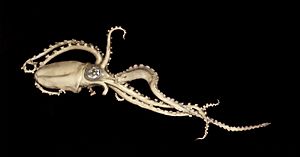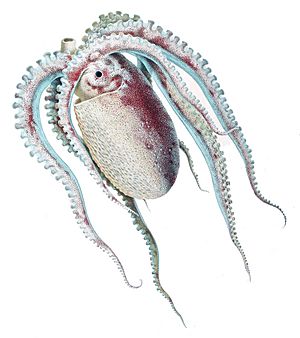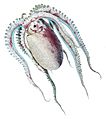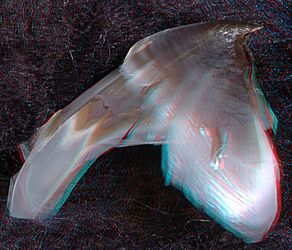Tuberculate pelagic octopus facts for kids
Quick facts for kids Tuberculate pelagic octopus |
|
|---|---|
 |
|
| Specimen preserved in formaldehyde | |
 |
|
| Conservation status | |
| Scientific classification | |
| Genus: |
Ocythoe
|
| Species: |
tuberculata
|
| Synonyms | |
The Ocythoe tuberculata, also called the tuberculate pelagic octopus or football octopus, is a type of octopus that lives in the open ocean. It is the only known species in its family, called Ocythoidae.
You can find Ocythoe tuberculata in warm and mild seas. They are often seen in the Northern Hemisphere, for example, in the North Pacific Ocean near California.
Contents
About the Football Octopus
Body Features
The Ocythoe octopus is special because it has a swimbladder. This is like a gas bag inside its body. It helps the octopus control how high or low it floats in the water. Scientists have watched them use it to move water in different directions.
The swimbladder sits on the octopus's insides. It also has nerves and blood vessels. Young octopuses have a thicker, jelly-like swimbladder. Adult octopuses have a less jelly-like one that is always open. Male octopuses do not have a swimbladder. The Ocythoe is the only cephalopod (a group that includes octopuses and squids) known to have a true gas bladder.
Where They Live
O. tuberculata mainly lives in the northern parts of the world's oceans. They are common in the Mediterranean Sea and parts of the North Atlantic Ocean. They have also been found in the northern Pacific Ocean.
Only a few have been seen in the southern parts of the Indian or Pacific oceans. These octopuses prefer warmer waters. Some scientists think warm ocean currents might carry them to new places.
These octopuses live near the surface of the ocean. They are usually found at depths between 100 and 200 meters (about 330 to 660 feet).
Life Cycle and Reproduction
Female tuberculate pelagic octopuses lay many eggs. They can produce almost 100,000 eggs at once. One female found in 2003 had over 1 million eggs! This is the most eggs ever recorded for any octopus.
The eggs are very small, about 1.75 millimeters long. This is common for octopuses that live in the open ocean. These octopuses are thought to be viviparous. This means their babies develop inside the mother's body.
Scientists are still learning exactly how and where the babies grow. Most agree that the eggs develop inside special tubes in the female's body. Fertilization happens when the male places a special arm, called a hectocotylus, into the female's body.
What They Eat
Scientists do not know exactly what Ocythoe octopuses eat. However, most octopuses are predators. This means they hunt other animals for food. Octopuses that live in the open ocean usually eat shrimp, fish, or other cephalopods.
Who Eats Them
Several animals hunt and eat Ocythoe octopuses. These include:
- Lancet fishes (like Alepisaurus borealis)
- Tunas (such as Thunnus alalunga)
- Risso's dolphin (Grampus griseus)
These predators can dive deep into the ocean. They often hunt O. tuberculata at depths between 100 and 200 meters.
Gallery
-
Male with an attached hectocotylus that has broken free from its sac
-
A very young O. tuberculata paralarva (baby octopus)







